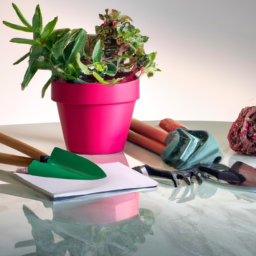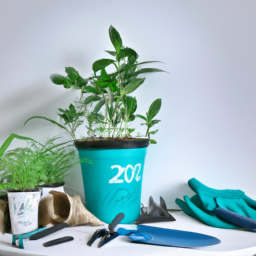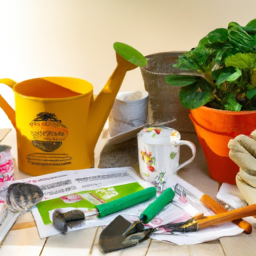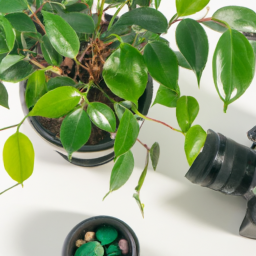
Are you a beginner looking to bring some greenery into your home? Look no further than the ultimate beginner’s guide to indoor gardening! Whether you have a spacious apartment or a tiny studio, indoor gardening is a fantastic way to bring nature indoors and enjoy the benefits of plants. With this comprehensive guide, we will walk you through everything you need to know to start your own indoor garden, even if you have never had a green thumb before. From choosing the right plants to understanding their needs, we will cover all the basics so you can create a thriving indoor garden that will bring joy and beauty to your space. So, let’s dig in and get started on your indoor gardening journey!
Benefits of Indoor Gardening: Exploring the advantages of cultivating plants indoors
Introduction
Welcome to the ultimate beginner’s guide to indoor gardening! In this comprehensive guide, we will explore the numerous benefits of cultivating plants indoors. Whether you have a spacious apartment or a small studio, indoor gardening allows you to bring nature inside and enjoy the beauty and benefits of plants right at home. Let’s dive in and discover why indoor gardening is becoming increasingly popular among gardening enthusiasts.
Enhancing Indoor Air Quality
One of the primary benefits of indoor gardening is its positive impact on indoor air quality. Plants act as natural air purifiers by absorbing carbon dioxide and releasing oxygen through the process of photosynthesis. Additionally, plants can filter out harmful toxins and pollutants present in the air, such as formaldehyde and benzene. By introducing plants into your indoor space, you can create a healthier and more refreshing environment for yourself and your loved ones.
Furthermore, studies have shown that indoor plants can help reduce the risk of respiratory illnesses and allergies. The moisture released by plants can increase humidity levels, preventing dryness in the air and reducing the likelihood of dry skin, sore throat, and other related discomforts. Indoor gardening truly brings the benefits of the great outdoors right into your home.
When selecting plants for better air quality, consider options such as peace lilies, spider plants, snake plants, and pothos. These plants are known for their ability to purify the air and thrive in indoor conditions.
Stress Reduction and Mental Well-being
Indoor gardening has been found to have a positive impact on mental well-being and stress reduction. The presence of plants indoors can create a calming and soothing environment, helping to alleviate stress, anxiety, and even symptoms of depression. The act of nurturing and caring for plants can also provide a sense of purpose and fulfillment.
Studies have shown that being around greenery and nature can enhance cognitive function, improve concentration, and boost overall productivity. Indoor gardening offers a convenient way to bring these benefits into your living or working space. Whether you choose to have a small herb garden in your kitchen or a collection of potted plants in your living room, the presence of nature indoors can have a profound impact on your mental well-being.
Consider incorporating plants with soothing scents, such as lavender or jasmine, to further enhance the calming effects of your indoor garden.
Connection with Nature, Even in Urban Environments
Living in urban environments often means limited access to green spaces and nature. However, indoor gardening provides an opportunity to reconnect with nature even in the heart of the city. Whether you have a balcony, a sunny window sill, or simply some free space on your desk, you can create your own green oasis.
Indoor gardening allows you to surround yourself with the beauty of plants, fostering a sense of tranquility and connection to the natural world. It brings a touch of the outdoors into your daily life, providing a refreshing escape from the concrete jungle.
With indoor gardening, you can choose from a wide variety of plants that thrive indoors, including succulents, herbs, ferns, and flowering plants. Experiment with different plant types and arrangements to create a personalized indoor garden that suits your taste and style.
Conclusion
Indoor gardening offers a multitude of benefits for both your physical and mental well-being. From improving indoor air quality to reducing stress and fostering a connection with nature, the advantages of cultivating plants indoors are undeniable. Whether you are a beginner or an experienced gardener, indoor gardening provides a rewarding and fulfilling experience.
So, why not embark on your indoor gardening journey today? Start by selecting the right plants for your space, ensuring proper light and watering conditions, and enjoy the numerous benefits that indoor gardening has to offer. Happy gardening!

Ultimate Beginner’s Guide to Indoor Gardening
2. Essential Tools and Supplies for Indoor Gardening: A comprehensive guide to the equipment needed for successful indoor gardening
Welcome to the Ultimate Beginner’s Guide to Indoor Gardening! In this comprehensive guide, we will walk you through the essential tools and supplies you need for successful indoor gardening. Whether you are a beginner or have some experience, having the right equipment is crucial for creating a thriving indoor garden.
1. Containers and Pots
The first step in indoor gardening is to choose the right containers and pots for your plants. Select containers that have drainage holes at the bottom to prevent waterlogging. This allows excess water to drain out, preventing root rot. Additionally, consider the size of the container based on the plant’s growth potential. Ensure the containers are made of durable and non-toxic materials to promote healthy plant growth.
There are various options available, including plastic, ceramic, terracotta, and fabric pots. Plastic pots are lightweight and retain moisture well, while ceramic and terracotta pots are more aesthetically pleasing and provide better drainage. Fabric pots are breathable and prevent overwatering.
Remember to clean and sanitize the containers before planting to prevent the spread of diseases and pests.
2. Potting Soil and Amendments
Choosing the right potting soil is crucial for the success of your indoor garden. Look for a well-draining soil mix specifically formulated for indoor plants. Avoid using garden soil as it may contain pests, diseases, and weed seeds.
Consider adding amendments like perlite, vermiculite, or coconut coir to improve soil aeration and water retention. These amendments help prevent soil compaction and enhance root development. Additionally, organic matter such as compost or peat moss can improve soil fertility and nutrient availability.
When repotting, ensure you have enough potting soil to fill the new container adequately. Regularly check the soil moisture level and adjust watering accordingly to maintain optimal growing conditions.
3. Watering Tools
Watering is an essential aspect of indoor gardening, and having the right tools can make the task easier and more efficient. Here are some essential watering tools:
a) Watering Can: Choose a watering can with a long spout to reach plants in different locations. Opt for a can with a detachable rose nozzle to control the water flow.
b) Spray Bottle: A spray bottle is useful for misting plants that require high humidity or for applying foliar sprays. It helps maintain proper moisture levels without overwatering.
c) Self-Watering Systems: Consider using self-watering systems like wicking pots or hydroponic setups to automate the watering process. These systems provide a consistent water supply to the plants, reducing the risk of over or under watering.
Remember to water your plants thoroughly, allowing water to drain out of the containers. Avoid leaving plants sitting in standing water, as it can lead to root rot and other issues.
4. Lighting
Proper lighting is crucial for indoor gardening, especially when natural light is limited. Most plants require at least 6-8 hours of light per day. Here are some lighting options:
a) Natural Light: Place your plants near windows that receive bright, indirect sunlight. South-facing windows usually provide the most light, while east or west-facing windows offer moderate light intensity.
b) Artificial Light: If natural light is insufficient, consider using artificial lighting sources such as fluorescent, LED, or high-intensity discharge (HID) grow lights. Choose lights with the appropriate spectrum for the plants you are growing.
Keep in mind that different plants have varying light requirements, so it’s important to research the specific needs of your plants to ensure they receive adequate light for healthy growth.
5. Pruning and Propagation Tools
Pruning and propagation are essential techniques for maintaining healthy and well-shaped indoor plants. Here are some tools you may need:
a) Pruning Shears: Pruning shears or scissors are used to trim and shape plants. Choose a high-quality pair with sharp blades for clean cuts.
b) Pruning Saw: A pruning saw is useful for cutting thicker branches or stems that cannot be easily handled by shears.
c) Rooting Hormone: Rooting hormone is used during propagation to stimulate root growth. It helps in the successful establishment of new plants from cuttings.
d) Seed Starting Trays: If you plan to start plants from seeds, seed starting trays with individual cells or compartments are useful for germination and early growth stages.
Regular pruning helps maintain plant shape, encourages bushier growth, and removes dead or diseased parts. Propagation allows you to create new plants from existing ones, expanding your indoor garden collection.
By following this comprehensive guide and having the essential tools and supplies, you are well on your way to successful indoor gardening. Remember to adapt the techniques and equipment based on the specific needs of your plants. Happy gardening!

Choosing the Right Plants for Indoor Gardening
Welcome to the ultimate beginner’s guide to indoor gardening! In this section, we will discuss tips and recommendations for selecting the best plants to grow indoors. Whether you have a green thumb or are just starting your gardening journey, choosing the right plants is crucial for a successful indoor garden.
Consider Your Indoor Environment
Before diving into the world of indoor gardening, it is important to consider the environment in which your plants will be living. Factors such as light, temperature, and humidity can greatly impact the growth and health of your indoor plants.
Firstly, assess the amount of natural light your indoor space receives. Some plants thrive in bright, direct sunlight, while others prefer indirect or low light conditions. Take note of the direction your windows face and the duration of sunlight exposure throughout the day. This information will help you determine which plants are suitable for your specific lighting conditions.
Secondly, consider the temperature and humidity levels in your home. Most indoor plants prefer temperatures between 60-75°F (15-24°C). Additionally, certain plants thrive in higher humidity environments, while others can tolerate drier conditions. Understanding these requirements will help you choose plants that will thrive in your indoor environment.
Assess Your Gardening Skills and Time Commitment
Another important aspect to consider when selecting plants for indoor gardening is your own gardening skills and the amount of time you can dedicate to plant care. Some plants are more forgiving and require less maintenance, making them ideal for beginners or individuals with busy schedules.
If you are new to gardening or have limited time for plant care, consider starting with low-maintenance plants such as pothos, snake plant, or ZZ plant. These plants are known for their resilience and ability to tolerate a variety of growing conditions. They require minimal watering and can withstand occasional neglect.
On the other hand, if you have more experience and time to devote to your indoor garden, you can explore a wider range of plant options. Plants like orchids, ferns, and herbs may require more attention and specific care routines. However, the satisfaction of successfully nurturing these plants can be incredibly rewarding.
Match Plants to Your Goals and Preferences
Lastly, consider your goals and preferences when selecting plants for indoor gardening. Are you looking to create a lush, green oasis or do you prefer flowering plants that add a pop of color to your space? Do you want to grow herbs for culinary purposes or focus on air-purifying plants?
Understanding your goals and preferences will help you narrow down your plant choices. If you are aiming for a visually appealing indoor garden, consider plants like pothos, philodendron, or ferns. These plants have beautiful foliage and can add a touch of elegance to any space.
If you are interested in growing herbs for cooking, consider plants like basil, rosemary, or mint. These herbs not only provide fresh flavors but also fill your home with delightful aromas.
For those looking to improve indoor air quality, consider plants like snake plant, spider plant, or peace lily. These plants are known for their ability to purify the air by removing toxins and releasing oxygen.
Remember, the key to successful indoor gardening is selecting plants that align with your environment, skills, and preferences. By considering these factors, you can create a thriving indoor garden that brings joy and beauty to your home.
Let’s bring it all home
Indoor gardening is a fantastic way to bring the beauty of nature into your home, even if you don’t have a backyard or outdoor space. Whether you’re a complete beginner or a seasoned green thumb, this ultimate beginner’s guide will help you get started with indoor gardening and turn your living space into a lush oasis.
First things first, choose the right plants for your indoor garden. Some popular options include pothos, spider plants, and succulents, as they are low-maintenance and can thrive in various lighting conditions. Next, consider the location for your indoor garden. Find a spot in your home that receives adequate sunlight, or if natural light is limited, invest in artificial grow lights to provide the necessary light for your plants to grow. Don’t forget to choose the right type of soil and containers for your plants, ensuring proper drainage and aeration. Lastly, remember to water your plants regularly, but be cautious not to overwater as it can lead to root rot. With these basics in mind, you’ll be well on your way to creating a thriving indoor garden that adds life and vibrancy to your living space.
Here are this week’s Top Questions and Answers
Q1: What is indoor gardening?
A1: Indoor gardening refers to the practice of growing and cultivating plants inside a controlled environment, typically within the confines of a home, office, or any other indoor space. It allows individuals to enjoy the benefits of gardening without requiring an outdoor garden or yard.
Q2: Why should I start indoor gardening as a beginner?
A2: Indoor gardening is a wonderful hobby for beginners because it offers numerous benefits. Firstly, it allows you to bring nature indoors, creating a calm and serene atmosphere. Additionally, indoor plants help purify the air, improve humidity levels, and reduce stress. Moreover, it’s a great way to grow your own herbs, vegetables, or beautiful flowers, providing you with fresh produce and a sense of accomplishment.
Q3: What are the essential supplies needed for indoor gardening?
A3: To get started with indoor gardening, you’ll need a few basic supplies. These include:
- Pots or containers with drainage holes
- High-quality potting soil
- Seeds or young plants
- Watering can or spray bottle
- Fertilizer
- Grow lights (if natural light is limited)
Q4: How do I choose the right plants for indoor gardening?
A4: When selecting plants for indoor gardening, it’s important to consider factors such as lighting conditions, temperature, and the amount of care required. Some popular indoor plants that are relatively easy to grow include spider plants, pothos, snake plants, and peace lilies. These plants are known for their resilience, adaptability, and ability to thrive in low-light environments.
Q5: What are some tips for successful indoor gardening?
A5: Here are a few tips to help you succeed in your indoor gardening journey:
- Understand the lighting needs of your plants and provide adequate light.
- Water your plants appropriately, taking care not to overwater or underwater them.
- Monitor humidity levels and consider using a humidifier if necessary.
- Regularly inspect your plants for pests and diseases and take necessary actions to control them.
- Follow a proper fertilization schedule to provide essential nutrients to your plants.
- Observe and learn from your plants, adjusting your care routine as needed.
Dr. Olivia Green is a botanist with over two decades of experience in indoor plant cultivation. She holds a Ph.D. in Plant Biology and has dedicated her career to researching plant behavior in controlled environments. Dr. Green is passionate about helping plant enthusiasts master the art of indoor gardening through her extensive knowledge and practical insights.


